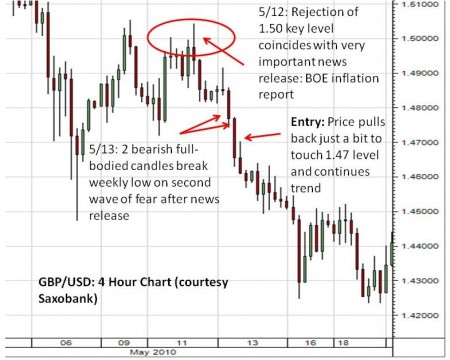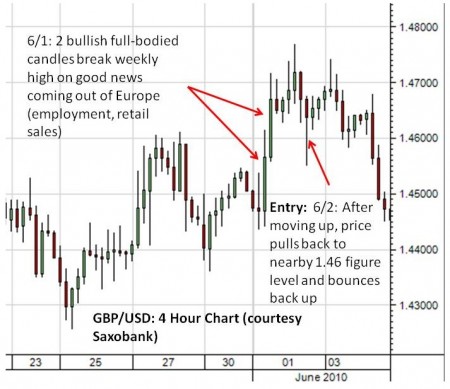Forex Crunch How to Make Profitable Entries in Your Forex Trading |
- How to Make Profitable Entries in Your Forex Trading
- Eur/Usd Trading – 3 Tips That Will Make You the Next George Soros!
- Forex Daily Outlook – July 29 2010
- The Pound rises by orders from the King
| How to Make Profitable Entries in Your Forex Trading Posted: 29 Jul 2010 02:51 AM PDT Guest post by Kris Matthews tradeforexfundamentally.com Have you ever put a trade on after seeing the market run nicely in one direction only to see the market immediately move in the opposite direction? Have you ever waited for a pair to come down to a specific price level that you were certain would hold, only to see the market blast right down through your entry without even caring? Chances are you've done your research and have a strategy for identifying turning points or trends, so that's not the issue. You've been selecting good currency pairs to trade with so that's not the issue. So what is it? Entries. I want to show you how to make optimal entries for forex profits, but first we need to get clear on two things:
Entries for trading the trendThe objective here is to get in, not so much at the right price level, but the right time. You want to find the setup on your price chart or in the news that most often leads to the beginning of a new trend. Here are some suggestions for entries to achieve maximal forex profits:
|
| Eur/Usd Trading – 3 Tips That Will Make You the Next George Soros! Posted: 28 Jul 2010 11:48 PM PDT Guest post from visionsofaffluence.com Ok, so maybe I exaggerated a bit about you becoming the next George Soros but with these tips you will definitely be able to make a lot of money. 1. Only trade it during the U.S European Overlap. That’s not to say that you can’t have success trading it at other times but if you want to make the most of your time then you should only trade from 8am – 12pm EST because both of the European and U.S markets are open. Also this is when the vast majority of all forex transactions take place and as a result the market will be extremely liquid so their will be great opportunity for profit. 2. Keep your stops a little wider than with other pairs. This is the most active currency pair of them all with more people trading it than any other. Because of this it is prone to erratic moves from time to time which could result in you taking a trade and the market moving against you quickly only to turn around and move back in the opposite direction. Because of this you should give your stops a little more leeway as compared to other pairs. Remember to adjust your risk accordingly. 3. Don’t be greedy. This is a fast moving pair so you may very well open a trade and find your self in profit quickly only for the market to turn around just as fast and leave you with a loss. Because of this you should lock in profits by closing out half of your position and moving your stop to break even once your position has reached a certain amount of profit. This is what’s known as a free trade and it ensures that no matter what you will profit no matter what happens If you follow these 3 tips you will become a more efficient trader of the Eur/Usd. This will result in you making more money in less time and isn’t that why we trade in the first place. Want to see what other traders are doing in real accounts? Check out Currensee. It's free.. |
| Forex Daily Outlook – July 29 2010 Posted: 28 Jul 2010 02:00 PM PDT U.S. Unemployment Claims the early indicator of Non-Farm Payrolls is the highlight of today’s news. Let’s see what awaits us today. In the US, Unemployment Claims rose last week to 464K worse than expected a smaller rise to 457K is expected now. As an early indicator of Non-Farm Payrolls it has a major effect on the U.S. currency.
In the US, Unemployment Claims rose last week to 464K worse than expected a smaller rise to 457K is expected now. As an early indicator of Non-Farm Payrolls it has a major effect on the U.S. currency. More in the US, Natural Gas Storage expected to reach 31B – 20B less than last week. In Canada, Raw Materials Price Index a leading indicator of consumer inflation forecasted 1.1% rise following the 7.2% dip in May. More in Canada, Industrial Product Price Index foreseen 0.3% rise as in the previous month. For more on USD/CAD, read the Canadian dollar forecast. In Europe, German Unemployment Change forecasted to continue decreasing by 18K following 21K drop in April. For more on the Euro, read the EUR/USD forecast and Casey Stubbs' latest analysis. In Great Britain, Nationwide House Price Index a leading indicator of the housing industry’s health expected 0.2% drop following a four month increase. More in Great Britain, Net Lending to Individuals measuring change in the total value of new credit issued to consumers is predicted to reach 1.3B following impressive rise to 1.5B in May shows an overall improvement in the British market. Finally in Great Britain, GfK Consumer Confidence index, a leading indicator of consumer spending based on a survey of about 2,000 consumers predicted a 2 point drop to -21 points. Read more about the Pound in the GBP/USD forecast. In New Zealand, Building Consents predicted a rise following the 9.6% drop in May. In Japan, Tokyo Core CPI releases CPI data a month ahead of National CPI forecasted 1.2% drop 0.1% stronger than in June indicating a deflation wave in Japan. The National Core CPI shows the same deflation trend with 1.0% drop. More in Japan, Prelim Industrial Production a leading indicator of economic health expected a 0.2% rise 0.1% better than in the previous month and Household Spending continues with a 0.7% drop as in the two previous months. That’s it for today. Happy forex trading! Want to see what other traders are doing in real accounts? Check out Currensee. It's free. |
| The Pound rises by orders from the King Posted: 28 Jul 2010 07:02 AM PDT Mervyn King finally changed his tone about inflation, and sent the British Pound above a critical resistance line. Update on the rising sterling.
Mervyn King and inflation – Background Mervyn King, governor of the Bank of England, dismissed the rising inflation in Britain for a long time. British inflation passed the government’s target range of 1-3% a long time ago. But King still saw the darker sides of the economy. Even when he was forced to write an inflation letter to the Chancellor of the Exchequer (Alistair Darling at that time), he blamed the rising prices on high oil prices, and played a big role in holding the pair down. But now the tables have turned. Just this Friday, the initial release for British GDP showed a growth rate of 1.1% in Q2, almost double the early expectations. Together with the improvement in employment, there are already lots of good signs for the British economy. Things are changing also inside the bank. In the past two meetings of the MPC, one member, Andrew Sentance, voted for raising the rates. He was the sole member to think so, but he’s backed by the new Prime Minister, David Cameron. And now, also Mervyn King acknowledges the rising inflation, and warned about it in an official appearance. In the same appearance, he also hinted that the interest rate wouldn’t rise soon back to “normal” levels. But while it won’t rise to “normal” levels, it could still rise. GBP/USD Jumps The Pound faced a strong hurdle at 1.5520. This line was the highest point in February, and proved to be a strong line, succeeding in stopping the Pound time after time. But now this line was broken – GBP/USD currently trades at 1.5630, jumping above this level and leaving dust behind it. The next level to watch is 1.5720, which was a support line in 2009, when the pair traded at a high range for a very long time. But a more significant line stands higher – 1.5833 – this was the support line that held GBP/USD before it collapsed to lower levels, and also worked as a resistance line when the pair made an attempt to recover. If this line is broken, the road is open to the round number of 1.60, and the resistance line at 1.6070. If the pair reverses its moves, immediate support is found at 1.5470, a line that was a resistance line not long ago, and 1.5350 – a pivotal line many times in the past. Want to see what other traders are doing in real accounts? Check out Currensee. It's free.. |
| You are subscribed to email updates from Forex Crunch To stop receiving these emails, you may unsubscribe now. | Email delivery powered by Google |
| Google Inc., 20 West Kinzie, Chicago IL USA 60610 | |



No comments:
Post a Comment